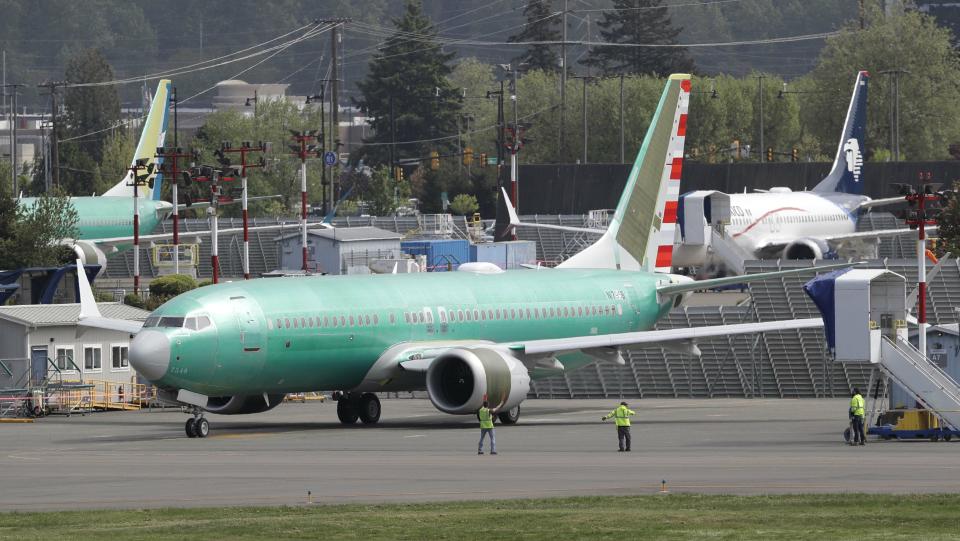The FAA expects Boeing's 737 Max 8 'fix' application next week
The Federal Aviation Administration expects Boeing (BA) to submit its formal and final application as early as next week for a software update to the 737 Max 8, grounded worldwide since March 13.
“Based on what they give us will determine whether the prohibition order will be lifted,” Daniel Elwell, acting administrator for the FAA, told the House Committee on Transportation and Infrastructure’s subcommittee on Aviation on Wednesday.
All Max 8 aircraft were grounded following the second of two similar crashes. Shortly after takeoff from Jakarta, Indonesia, on October 29, Lion Air Flight 610 crashed into the Java Sea. Ethiopian Airlines Flight 302 similarly crashed shortly after takeoff from Addis Ababa, Ethiopia, on March 10. Both crashes killed all passengers and crew on board.

Elwell did not say how long the FAA’s review of the proposed software fix would take, but said the agency plans to host a meeting with civil aviation authorities from around the world on May 23 to discuss the FAA’s activities toward ensuring the safe return of the 737 max to service.
‘How did that get cerfified?”
Wednesday’s testimony largely focused on the Max 8’s controversial MCAS system, known to have been activated in both crashes. Representatives probed Elwell and regulators from the NTSB on whether the feature and the way it was introduced by Boeing were responsible for the fatal crashes.

“Is the MCAS a safety-critical system in your opinion?” Rep. Peter DeFazio (D-OR) asked.
“I didn't make that designation, but it seems to me that yes it is,” Elwell said, though he disagreed with DeFazio’s suggestion that MCAS, as originally installed, was too reliant on pilots as a backup for MCAS failures.
“The argument is pilots are supposed to correct the system,” DeFazio said, pointing out an additional critique of MCAS in that Boeing failed to accurately represent MCAS-related features in aircraft manuals. “Until after Lion Air, pilots didn't know the system was installed. Is that correct?”
“Yes sir,” Elwell responded. Representatives also pointed out that in an audio recording obtained by CBS news, American Airlines (AAL) pilots reportedly raised concerns about the MCAS system between the two crashes.
Boeing has said some Max 8 planes were delivered to airline customers with angle of attack (AOA) sensor display software that didn’t meet the company’s requirements. Data from the plane’s AOA sensor, which was designed to feed data to MCAS, was linked to an AOA indicator in such a way that disabled the AOA disagreement light in the airplane cockpit for customers that did not also purchase the indicator.
Boeing first notified customers of the issue after the Lion Air crash, even though its engineers identified the software discrepancy more than a year beforehand.
“Boeing knew for more than a year before that crash that the disagree light didn't work unless you bought their optional package,” DeFazio said. “How did that get certified?”
Boeing has maintained that neither the indicator nor the disagree alert are necessary for the safe operation of the airplane. Elwell urged the committee not to make the issue. Elwell acknowledged that he was not happy with the 13-month delay between Boeing’s knowledge of the software anomaly and the FAA receiving notice of it, though he emphasized the agency’s position that it did not cause a safety issue.
“The AOA disagree light is an advisory,” he said. “And the AOA disagree light would not have changed in either accident. I want to make sure everybody understands: Don't don't make something that isn't a critical safety item, a critical safety item, because there are enough critical safety items for us to focus on.”
When asked whether regulators would require comprehensive simulator training for pilots to fly the potentially re-certified Max 8, Elwell said that was yet to be decided.
“We need to wait for the Boeing application of the fix,” Elwell said. “Once we have the official application of the fix we will be able to determine if and exactly what sort of training will be required for max pilots.”
Alexis Keenan is a New York-based reporter for Yahoo Finance. She previously worked for CNN and is a former litigation attorney. Follow on Twitter @alexiskweed.
Follow Yahoo Finance on Twitter, Facebook, Instagram, Flipboard, SmartNews, LinkedIn,YouTube, and reddit.

 Yahoo Finance
Yahoo Finance 